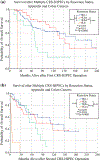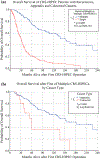Repeat Cytoreductive Surgery with Hyperthermic Intraperitoneal Chemotherapy for Cancers with Peritoneal Metastasis: A 30-year Institutional Experience
- PMID: 35286531
- PMCID: PMC10088912
- DOI: 10.1245/s10434-022-11441-3
Repeat Cytoreductive Surgery with Hyperthermic Intraperitoneal Chemotherapy for Cancers with Peritoneal Metastasis: A 30-year Institutional Experience
Abstract
Background: Cytoreductive surgery with hyperthermic intraperitoneal chemotherapy (CRS-HIPEC) improves survival in abdominal cancer patients with metastatic disease limited to the peritoneal cavity. Patients are increasingly being offered repeat CRS-HIPECs for peritoneal recurrence. However, in this rare clinical scenario, the survival benefit of performing repeat CRS-HIPEC operations remains unclear.
Methods: A retrospective review of the CRS-HIPEC database at Wake Forest Baptist Medical Center was performed over a 30-year timespan. From 1547 patients with appendix cancers, colorectal cancers, mesotheliomas, and other miscellaneous cancers, 156 received more than one CRS-HIPEC. Kaplan-Meier survival analysis was performed using overall survival (OS) from the time of surgery as the primary endpoint. Multi-variable Cox proportional hazards regression modelling was performed on pertinent clinical variables.
Results: Patients who received multiple CRS-HIPECs had significantly better median OS (10.7 years) versus those who received one CRS-HIPEC (2.5 years), with appendix cancers faring best (12.9 years). Resection status R2a or better was achieved in 76.4% of repeat CRS-HIPECs. There were no significant changes in complication rates after repeat CRS-HIPEC. On multivariate analysis of repeat CRS-HIPEC, patients with appendix and colorectal cancers, heart disease, and poor functional status were independently associated with poor OS. Factors not independently associated with OS were age, sex, body mass index, race, diabetes, lung disease, smoking history, and systemic chemotherapy between CRS-HIPECs.
Conclusions: Performing multiple CRS-HIPEC operations on appropriate surgical candidates may significantly prolong survival. Appendix cancers derived the greatest benefit. Satisfactory resection margins and complication rates are comparable to first cases and achievable in repeat CRS-HIPEC procedures.
Keywords: Cytoreductive surgery; HIPEC; Hyperthermic intraperitoneal chemotherapy; Peritoneal surface malignancy; Repeat HIPEC; Repeat cytoreductive surgery.
© 2022. Society of Surgical Oncology.
Conflict of interest statement
Figures



References
-
- Glehen O, Kwiatkowski F, Sugarbaker PH, et al. Cytoreductive surgery combined with perioperative intraperitoneal chemotherapy for the management of peritoneal carcinomatosis from colorectal cancer: a multi-institutional study. J Clin Oncol. 2004;22:3284–92. - PubMed
-
- Yan TD, Black D, Savady R, Sugarbaker PH. A systematic review on the efficacy of cytoreductive surgery and perioperative intraperitoneal chemotherapy for pseudomyxoma peritonei. Ann Surg Oncol. 2007;14:484–92. - PubMed
-
- Verwaal VJ, Bruin S, Boot H, van Slooten G, van Tinteren H. 8-Year follow-up of randomized trial: cytoreduction and hyperthermic intraperitoneal chemotherapy versus systemic chemotherapy in patients with peritoneal carcinomatosis of colorectal cancer. Ann Surg Oncol. 2008;15:2426–32. - PubMed
-
- Chua TC, Moran BJ, Sugarbaker PH, et al. Early- and long-term outcome data of patients with pseudomyxoma peritonei from appendiceal origin treated by a strategy of cytoreductive surgery and hyperthermic intraperitoneal chemotherapy. J Clin Oncol. 2012;30:2449–56. - PubMed
MeSH terms
Grants and funding
LinkOut - more resources
Full Text Sources
Medical

